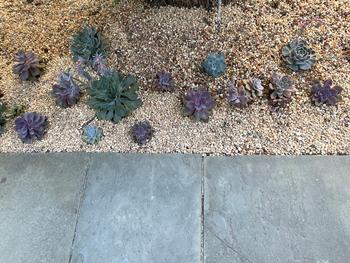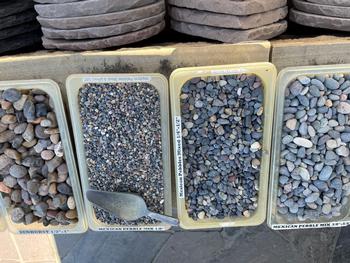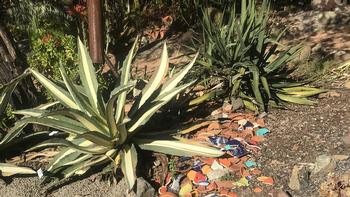Design a defensible space around your home with a variety of fire-safe mulches
-
Jane Scurich
-
UC Marin Master Gardeners (MMG) have a few standard mantras: right plant, right place; compost, compost, compost; and mulch, mulch, mulch.
 A 4' blue stone pathway leads to drought tolerant succulents mulched with 3/8” stones provide a defensible space next to a house. Photo: Jane Scurich
A 4' blue stone pathway leads to drought tolerant succulents mulched with 3/8” stones provide a defensible space next to a house. Photo: Jane ScurichWhat’s the right mulch for a plant that is in the right place, planted in soil incorporating lots of compost, AND promotes a defensible space - space needed to slow or stop the spread of wildfire?
Mulch is basically a protective blanket placed over the soil to conserve water, deter weeds, reduce erosion, and enhance your garden’s appearance. At one time, mulch was a simple subject. But in recent years, as fire danger has continued to increase, MMGs have incorporated the advice of CAL FIRE’s much more strategic recommendations for types of mulch and the ways to use it.
Do you remember organic and inorganic chemistry classes? Challenging – right? Mulch is also a bit challenging.
Think of your property in three zones: Zone 0 extends from your home or other buildings on the property to 5 feet. Zone 1 extends from 5 to 30 feet. Zone 2 extends from 30 to more than 100 feet. The choice of mulch for each zone will differ in type and the amount used.
For Zone 0, inorganic mulch is highly recommended.
What is inorganic mulch? Anything that is not comprised of living matter. Inorganic compounds generally have high melting points. Fire-safe inorganic mulches include rocks, pebbles, pavers, decomposed granite, bricks, and gravel. Rubber mulch is also inorganic, but it is highly flammable and not recommended close to homes. Pebbles and stones come in a variety of shapes and sizes to be used creatively throughout the garden. Photo: Jane Scurich
Pebbles and stones come in a variety of shapes and sizes to be used creatively throughout the garden. Photo: Jane ScurichOur local landscape supply stores carry an amazing array of attractive rocks and pebbles to enhance the beauty of your home and garden while adding a defensive space. Consider which inorganic product works best in your landscape. Don’t feel that you need to limit yourself to one product. Think about your various garden rooms and which rock product looks best. Most products can be purchased in bags by the pound or in bulk.
Unleash your creativity as you study the multitude of rocks and pebbles available in a wide range of colors and sizes with enticing names like “gold pathway rock,” “ocean lava,” and “Mexican pebble buttons.” Selecting the perfect inorganic mulch to surround your building structures can be an engaging decorating project.
Once you have completed your plans for Zone 0, a variety of organic mulches can be used in Zone 1. Composted wood chips or bark nuggets are considered to be the least hazardous. These chips are partially decomposed, containing fine particulate and larger wood chips, and are marketed under various names. Free wood chips often offered by local tree services should not be used within zone 0, but they can be used in a thin layer in zone 1. In Zone 1, do not spread mulch more than 2 inches deep. As you design your mulch areas, think about breaking up planting areas with some type of inorganic mulch or hardscaping, creating defensible spaces among your garden beds. The succulent garden at the Falkirk Cultural Center displays a creative mix of broken tiles and pottery used as mulch. Photo: Jane Scurich
The succulent garden at the Falkirk Cultural Center displays a creative mix of broken tiles and pottery used as mulch. Photo: Jane ScurichNot many of us have a Zone 2 in our landscape. Pine needles, shredded rubber, and bark can be used with caution and concern for vegetation in that zone. Consider the density of trees, shrubs, and other plants that might add fuel for wildfires before adding flammable mulches. Break up planted areas with non-combustible material.
For many years, shredded western red cedar, also known as gorilla hair, was recommended for use on hillsides as it naturally holds together and doesn’t slide off as other products might. It is highly flammable and should not be used close to any structures, including wood fences and decks.
Much more fire-safe advice is found on our website: https://marinmg.ucanr.edu/BASICS/FIRESMARTLANDSCAPING/Plan/#zones. Fire danger is part of living in Marin. Start your work in Zone 0. Treating fuels within the first five feet of structures is one of the most important aspects of hazard mitigation. Prepare your garden to be a defensible space, and encourage your neighbors to join you. We’re all in this together.



